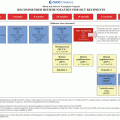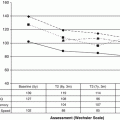© Springer New York 2015
Grace A. Mucci and Lilibeth R. Torno (eds.)Handbook of Long Term Care of The Childhood Cancer SurvivorSpecialty Topics in Pediatric Neuropsychology10.1007/978-1-4899-7584-3_2525. Rehabilitation Consideration in Pediatric Cancer Survivors
(1)
Division of Child and Adolescent Psychiatry and Behavioral Sciences, Children’s Hospital of Philadelphia, 34th Street and Civic Center Boulevard, Philadelphia, PA 19104-4399, USA
(2)
Department of Physical Medicine, Our Children’s House at Baylor, 1208 N. Hall Street, Dallas, TX 75204, USA
(3)
Department of Speech-Language Therapy, National Rehabilitation Hospital, 2200 Research Blvd., #345, Rockville, MD 20850, USA
Keywords
RehabilitationPediatric cancerPhysical therapyOccupational therapySpeech and language therapy25.1 Introduction
Cancer rehabilitation has been broadly defined as “an interdisciplinary team approach to helping patients and their families maximize their level of independence physically, emotionally, and spiritually within the limitations of their disease” [1]. Interdisciplinary rehabilitation team members often consist of many different professionals, such as physicians, nurses, social workers, psychologists/neuropsychologists, child life specialists, and rehabilitation therapists. Specific therapies may include any combinations of services, such as physical, occupational, speech-language, recreation, and other cognitive remediation therapies. More recently, Gamble, Gerber, Spill, and Paul defined the subspecialty of cancer rehabilitation as “any rehabilitation assessment, diagnosis, or functional intervention needed by and provided for any cancer patient at any moment along the continuum of their cancer care” [2].
Given that many pediatric cancer survivors suffer from “late effects” of the cancer and related treatments [3], rehabilitation issues often continue to be important in the long-term well-being of these survivors. Although there have been considerable improvements in survival rates for many childhood cancers, issues of morbidity continue to be of great concern. For example, Lackner et al. [4], prospectively studied 223 childhood cancer survivors and found that 75 % of the children in their long term follow-up group had at least one chronic medical problem. The organ system that was most often impacted was the nervous system (30 %), which has many implications for the need for ongoing rehabilitation services. Thus, therapies to address physical, speech-language, and cognitive functioning are particularly relevant in this population.
It has been known for many years that there is a need for rehabilitation services within cancer survivors, although the need for rehabilitation services has been studied mostly in adults. Lehmann et al. [5] conducted a retrospective chart review of 805 cancer patients from 4 different institutions. The goals of this study were to determine rehabilitation problems by cancer type/site, assess need for rehabilitation services, and to assess for gaps in delivering effective rehabilitation services. In the population studied, greater than 50 % had at least one problem defined as a “rehabilitation” issue, including paralysis, paresis, cognitive deficits (i.e., intellectual, perceptual), communication deficits, contractures, pressure sores, difficulties with ambulation or transfers, self care issues, fractures, and lymphedema. Psychological problems were more prevalent throughout the entire population studied, but even more so in those with physical disabilities versus those without (i.e., ~50 % in those with a physical issue and 29 % in those without). The authors noted that many of the subjects did not get appropriate rehabilitation services for their particular issue and that failure to get services often related to a lack of familiarity with rehabilitation services by the treating physician and failure to identify the rehabilitation problems.
Although the Lehmann et al. study was conducted more than 30 years ago, Paul and Buschbacher [6] report that many of the same barriers exist today. These authors note that a significant contributing factor behind skyrocketing healthcare costs in the world of oncology relates to the incomplete detection of rehabilitation, psychological, vocational, and financial needs in the cancer patient which in turn lead to poorer outcomes and quality of life issues. Given these concerns, a recent supplement in the American Journal of Physical Medicine and Rehabilitation (Vol 90, No 5) was published with the purpose of “increasing awareness of the role of rehabilitation in cancer care among the public and among medical professionals, as well as to stimulate further interest and training in the field of cancer rehabilitation” [6].
There may be multiple ways in which rehabilitation services can be helpful in the cancer population. Dietz is best known for introducing the idea of adaptive cancer rehabilitation as early as the 1960s. In 1981, Dietz suggested that there are four categories of cancer rehabilitation [7]. These are: preventative, where rehabilitation is aimed at improving physical functioning and reducing morbidity and disability; restorative, where cure is likely and the sequelae of cancer treatment are to be controlled; supportive, where the aim is to lessen disability when cancer is not eliminated but continues with periods of remission; and palliative, where there is advanced, active disease and control of symptoms and disability is required. Rehabilitation may also be thought of as treatment for acute vs. long term or chronic issues. For example, children recovering from a surgical resection of a brain tumor may undergo a period of intensive inpatient or outpatient rehabilitation in order to maximize their functioning and return to home and school life. In these circumstances, the goal is to capitalize on the rapid phase of recovery that is often seen in the initial weeks/months following an injury to the brain, such as in the case of a surgical tumor resection. In other cases, the goals of rehabilitation may be to treat more long-term issues, such as impact of limb amputation in an individual with osteosarcoma or in the case of cognitive late effects (secondary to radiation and chemotherapy treatments) seen in children with CNS cancers.
Given that rehabilitation may be helpful across phases of recovery, Heath [8] suggests that rehabilitation services may be beneficial to all childhood cancer patients in order to optimize their functioning and quality of life. This includes all parts of the spectrum, i.e., those in which there is a strong potential to be “cured” (e.g., ALL); those whose health may be maintained with periods of remission and relapse (e.g., childhood brain tumors); those whose cancer is likely to cause significant disability and reduced functioning (e.g., osteosarcoma); and even in those whose cancer is likely to be a terminal illness. Although one may not think of providing rehabilitation to those who have a terminal diagnosis, there may be situations in which such services can be quite helpful. For example, our facility once treated a school-age child with a recurrent brain stem glioma with poor prognosis. This young lady had significant difficulties with mobility, resulting in increasing isolation and loss of independence. In this case, the child benefitted from physical therapy to assist with increasing independence, decreasing isolation, and allowing her more autonomy when coping with end of life issues.
The focus of this chapter will be on long-term rehabilitation needs in survivors of pediatric cancer. It is meant to be a review of some of the most important issues to consider with regard to mobility, activities of daily living, swallowing, speech production, and language functioning. A few particular pediatric cancers will be highlighted, as these cancers tend to have higher impact on neurological functioning (e.g., CNS brain tumors) and mobility (e.g., osteosarcoma). Particular attention will be paid to posterior fossa tumors, as these are the most common brain tumors diagnosed in childhood. Treatment and surgical resection may result in a group of symptoms known as “posterior fossa syndrome” and are characterized by behavioral changes, irritability, emotional lability, mutism and speech deficits, difficulty following verbal commands, nystagmus, dysphagia or swallow deficits, cranial nerve palsies, and motor deficits, among other signs and symptoms [9].
25.2 Mobility, Activities of Daily Living, and General Physical Activity
25.2.1 Impact of Musculoskeletal Functioning
Adult survivors of pediatric cancer may experience a number of musculoskeletal issues, including amputation, arthritis, osteopenia, and fractures [10]. These are more frequently found in bone-tumor survivors; however, these issues may result in survivors of other types of cancers [11]. This may be in part due to the unintended effects of chemotherapy and radiation on bone and muscle health [12].
Haddy and Haddy [13] noted that the musculoskeletal effects of radiation therapy can be even more pronounced in survivors of pediatric cancer, as the tissues of children and adolescents are still developing and tend to be more susceptible to side effects. More specifically, radiation can cause premature closure of the epiphyses which can lead to limb-length discrepancy [3]. In turn, limb-length discrepancy can lead to functional scoliosis, chronic back pain, or knee and hip pain in the functional limb [14]. Radiation may also lead to spinal deformities (scoliosis, lordosis, and kyphosis) or an overall decrease in bone mineral density [12].
As addressed in a previous chapter, chemotherapy also has detrimental effects on the musculoskeletal system. Chemotherapy agents may also lead to limitations in soft tissue growth, reduced bone density, or osteonecrosis [12]. In addition, corticosteroids can result in decreased bone mineralization, stunted bone growth, or avascular necrosis [10]. Adult survivors of pediatric cancer may not reach peak bone mass as a result of their cancer and/or treatment. This often results in osteoporosis/osteopenia and possibly even osteonecrosis which can lead to fractures, muscle or bone pain, or spinal deformities (scoliosis, lordosis, and kyphosis) [13].
Other musculoskeletal issues related to this area are a result of limb-sparing procedures for osteosarcoma. While there is an obvious initial change after these surgeries, what may be less obvious are the long term effects which may result. According to the Children’s Oncology Group, individuals who have undergone limb sparing procedures are at risk for limb-length discrepancy, contractures, or chronic pain [12]. Other possible complications from the surgery include prosthetic loosening (when the implanted joint loosens or wears out) or nonunion (when one or both ends of the bone do not heal properly).
Individuals who have undergone amputation may also deal with complications such as prosthetic issues, skin breakdown, residual limb pain, phantom limb pain, and bone overgrowth [11]. Unfortunately the effects of amputation and limb-sparing surgery are not necessarily limited to the residual limb. The unaffected extremity and its joints may experience increased stress as a result of overuse and may age more rapidly, particularly in weight-bearing joints. According to Gailey et al. [14], amputation and long term prosthetic use can also lead to osteoarthritis, osteopenia, osteoporosis, and back pain. Individuals who have undergone amputation or limb-sparing procedure are also at risk for weight gain and possibly diabetes due to decreased physical activity secondary to increased energy and effort required to perform even simple activities [12].
The musculoskeletal issues caused by childhood cancer can lead to a significant impact on an individual’s functioning, including decreased independence with self-care, limited engagement in education and employment opportunities, and decreased participation in health and wellness activities. Therefore the Children’s Oncology Group has outlined specific screening measures and evaluations to ensure these issues do not go unnoticed [12]. Some of the recommendations include spinal exams, bone density evaluations, yearly height and weight measurements, and a history of the patient highlighting any joint pain, swelling, or immobility. In addition for those patients who have undergone limb-sparing procedures or amputations, the residual or affected limb should be periodically examined, as well as the prosthesis when appropriate.
25.2.2 Impact of Neurological and Sensory Functioning
While neurological and sensory issues are more commonly associated with tumors of the central nervous symptom, there is the potential for these symptoms to occur in survivors of other types of cancer as well. Goldsby et al. [15] found that survivors of ALL were at an increased risk for late-onset motor and coordination problems, seizures, and headaches. Survivors may not initially attribute these symptoms to their childhood cancer; therefore it is important for healthcare professionals to be aware of them given their ability to significantly impact functioning.
One sensory system that may be impacted by childhood cancer is the visual system, reviewed in more detail elsewhere. Briefly, radiation, certain chemotherapy agents, and extensive steroid use can predispose an individual to the development of cataracts. Radiation and certain chemotherapy drugs have also been linked to vision loss [10]. Additionally, individuals who have experienced orbital/eye radiation or higher doses of cranial radiation may be at risk for developing ocular toxicity, which can lead to multiple visual problems such as glaucoma, retinopathy, or optic chiasm neuropathy [12]. Therefore, annual eye exams are recommended, as well as a history of the patient highlighting any visual changes. Changes in vision have the potential to impact multiple aspects of an individual’s functioning including reduced mobility and greater need for assistance with activities of daily living. Working with an occupational or physical therapist with expertise in vision loss can be quite beneficial in these cases.
Another sensory system that may be affected by childhood cancer is the hearing/vestibular system. Higher dosages of radiation and certain chemotherapy drugs may lead to ototoxicity, which can result in hearing loss (sensorineural or conductive), tinnitus, or eustachian tube dysfunction [12]. Damage to the inner ear can be especially harmful, as this may lead to vertigo and/or changes in balance, which may impair an individual’s mobility and put them at an increased risk of falling [16].
One significant neurological effect that may occur as a result of childhood cancer is leukoencephalopathy. As the white matter of the brain undergoes changes as a result of chemotherapy or radiation, various neurological symptoms may occur such as spasticity, ataxia, hemiparesis, or seizures [3]. Certain chemotherapy drugs may also predispose an individual to peripheral sensory or motor neuropathies. Individuals experiencing sensory neuropathies may be limited by pain or dysesthesias, or may be at increased risk for skin issues secondary to decreased sensation. Those experiencing motor neuropathies may be limited by loss of reflexes, decreased strength, or changes in balance or mobility.
These types of symptoms can have a significant impact on an individual’s ability to fully engage in day to day activities, and may pose safety risks as well. Therefore, the Childrens Oncology Group (COG) recommends annual neurological exams to screen for these neurological symptoms, as well as a thorough history. If a patient’s functioning is being affected by neurological symptoms, they may benefit from a referral to rehabilitation services. For example, an individual experiencing foot drop as a result of a motor neuropathy would likely benefit from treatment from a physical therapist, who can work on strengthening or may recommend an orthosis. Individuals with decreased sensation in their hands may benefit from working with an occupational therapist who can improve what coordination is still available, as well as educate the patient on compensatory techniques [17].
25.2.3 Impact of General Health and Wellness
According to Schmidt et al. [10], nearly two-thirds of survivors of childhood cancer will develop chronic health conditions. For a quarter of these individuals, these conditions will be moderate, severe, or even life threatening. These effects may occur initially after treatment ends, or may not appear for several years. If survivors are made aware that their childhood cancer places them at an increased risk for certain conditions, they may be more likely to engage in healthy behaviors and willing to avoid harmful ones.
Ness et al. [17] examined physical performance limitations among adult survivors of childhood brain tumors. Results indicated that survivors had reduced grip and knee extension strength and lower peak oxygen uptake as opposed to the comparison group. In this particular study, the median age of survivors was 22 years old, but their muscle strength and fitness level was similar to that of the 60+ age group. The authors also determined that survivors had lower physical performance, which was associated with not living independently and not attending college. Obviously, this places this particular group of individuals at risk for a number of challenges that require ongoing evaluation and periodic intervention if needed.
Childhood cancer and its treatment can also lead to various cardiovascular and respiratory issues which can have a significant impact on an individual’s general health and wellness. For example, radiation in specific areas of the body and certain chemotherapy drugs can lead to cardiac toxicity, which may present as congestive heart failure, cardiomyopathy, myocardial infarction, or atherosclerosis of the heart. Similarly, radiation and chemotherapy treatments may also lead to pulmonary toxicity, which may present as pulmonary fibrosis, interstitial pneumonitis, or restrictive lung disease [17].
Studies show that survivors are less likely to meet recommendations for physical activity than their sibling counterparts [18]. Additionally, there is a higher rate of obesity and overweight status among survivors of childhood cancer, particularly in those patients treated with cranial radiation. On the other hand, a significant proportion of survivors are underweight as adults [13].
Stay updated, free articles. Join our Telegram channel

Full access? Get Clinical Tree






